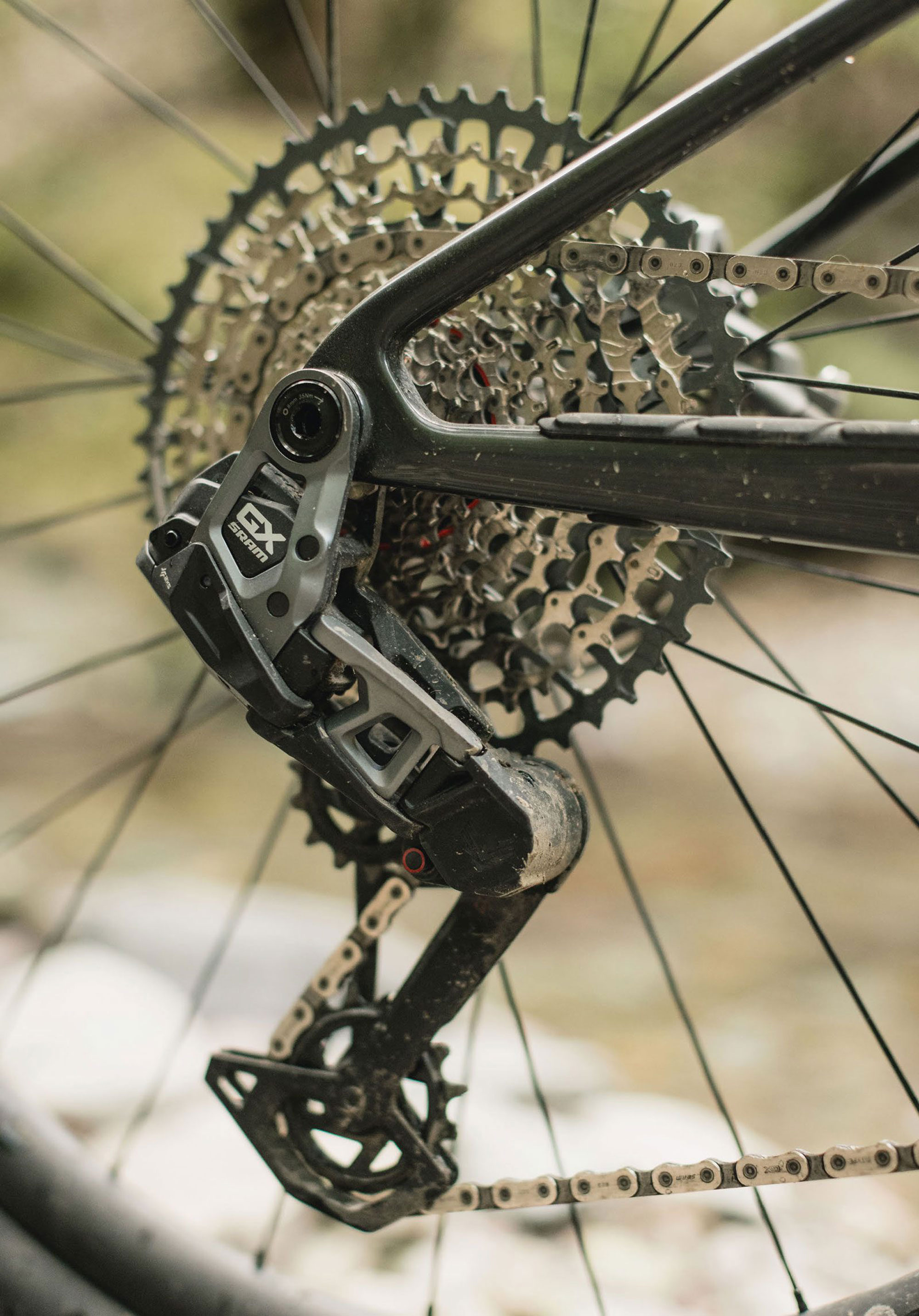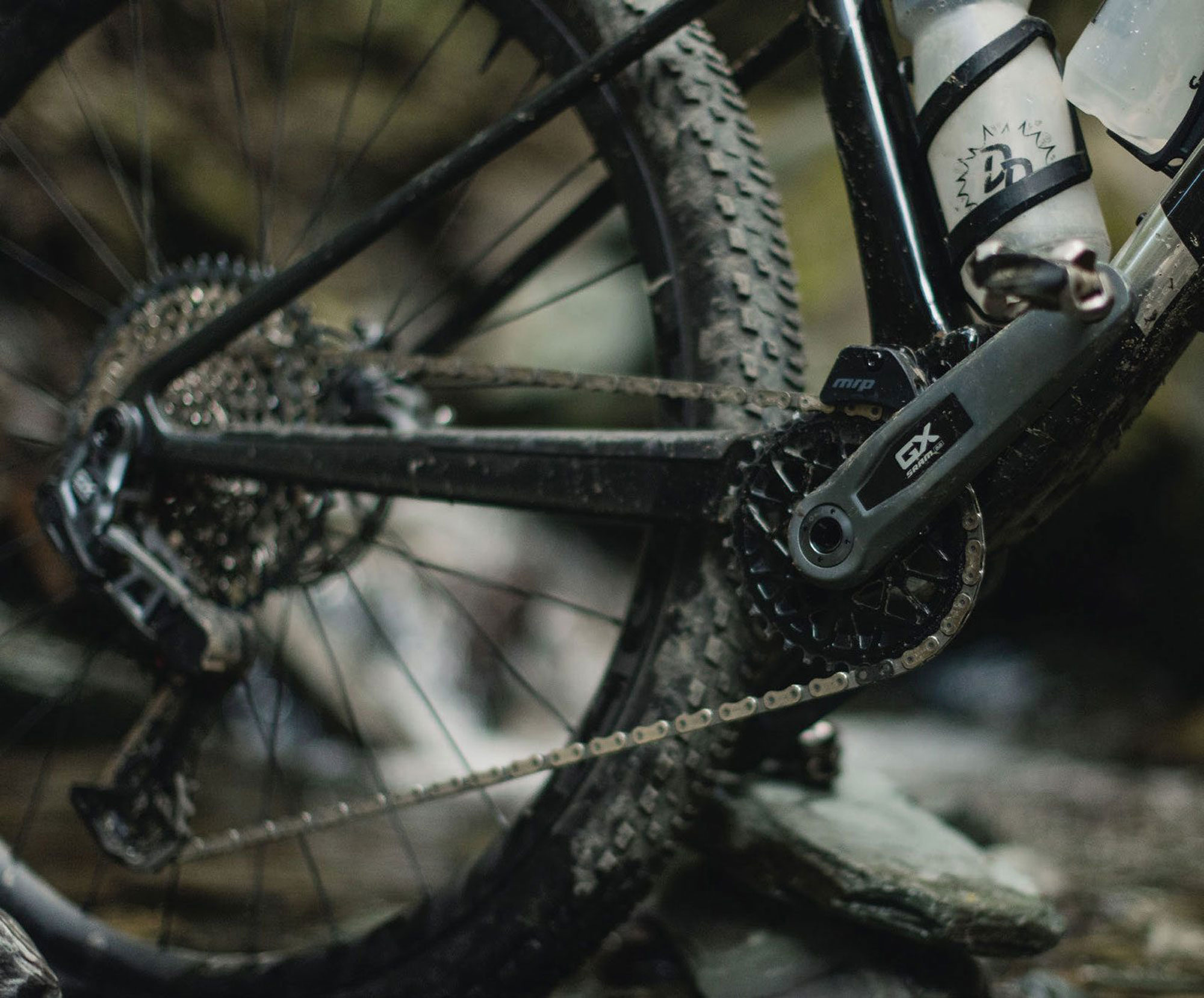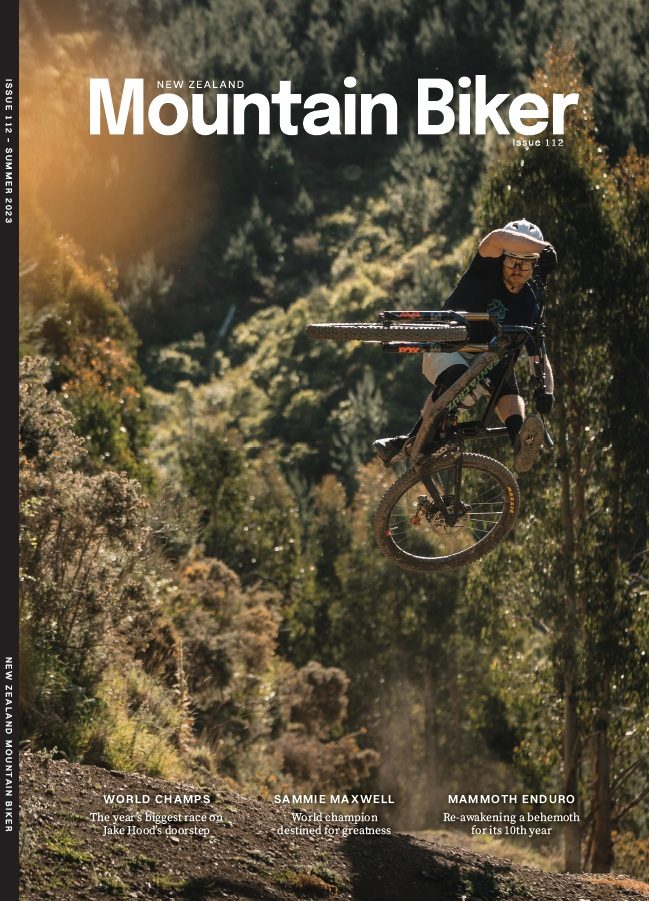Words Lester Perry
Images Cameron Mackenzie
I’ve been aboard the SRAM GX Transmission for a few months now. During that time, I’ve been lucky enough to put this groupset to the test across a wide variety of conditions, on two very different bikes, and on everything from party laps with mates to full gas cross country racing.
My first experiences of the transmission were aboard my Trek Slash. A thoroughbred enduro rig, I’ve held this bike back from its true potential for a solid couple of years and it just keeps on giving. After a summer of just riding short-travel trail and XC bikes, I decided to solely ride the Slash over winter, no other bikes, so it got a good amount of use. I’d changed up a few things in my setup, including running vastly beefier tyres than usual, shorter cranks, and different suspension settings, and loved the changes. At the start of winter, the GX T-type groupset arrived and took the bike to a whole new level of awesome. In our previous issue, I discussed my initial thoughts after a couple of rides, mentioned a couple of minor issues, and was left with some questions about longevity and whether I’d still be so enthusiastic about the groupset after a few months.
A fair amount of literal and figurative water has passed under the bridge since I began riding the Transmission, and I’m confident to say that, for me, it’s a complete winner. But – it does take some getting used to. I sat back on one of my cable actuated geared bikes for a few laps of the street yesterday, just to be sure. Yep, I’m still confident it’s better in most cases.
The Triple Crown is the Rotorua MTB Club’s annual winter enduro; three stages on Rotorua’s finest grade 4+ trails. Rain had dampened the trails, but not to the point of total saturation; Rotorua’s volcanic soil effectively absorbing up most of the rain, leaving just enough puddles in the native bush to get a drive train nice and gritty. Aboard the GX mounted Slash, a quick few laps on the eve of the race to warm up, and over the three race stages during the following day – again highlighting the things I rate about the Transmission.

It’s quiet, the new clutch layout means less chain movement and a much quieter system – particularly when bombing fast, rough sections or hucks-to-flat; way less chain slapping the rear stays.
When racing Enduro, particularly on chunky rough or off-camber sections, you simply can’t get the pedals around everywhere you’d like to – so every pedal stroke counts. Short high-powered efforts, and lots of them; there’s no time for a wasted crank rotation to engage a partially derailed chain and, if you’re exiting a corner and need to be in a different gear, good luck with shifting a traditional setup under full power. The positive, solid feeling Transmission offers just can’t be beaten in this department. Go on, pedal full gas every time, all the time! I’ve been shifting more and throwing meaningful pedal strokes in where previously I simply wouldn’t have bothered or trusted my drive train under that level of aggression.
After my initial rides, I was concerned about smashing the low-hanging ‘Pod’ shifter off its perch – and I sure came close. At the Triple Crown, I managed to wash the front wheel on a root, sending me into a tree and a huge over-the-bars. Handlebars twisted and somewhat confused as to what had happened, I finished the run with a twisted cockpit, and when I went to shift gear into the finish of the trail there was no shifter to be seen. “That’s it, I knew this would happen at some point” was my first thought. Off the bike and about to walk up the track to hopefully retrieve the missing shifter, I realised it had just rotated around the bar and was now sticking out the front. Relief. With a quick twist of the mount, the shifter was back in its rightful place. I generally keep my cockpit controls loose enough on the bars to allow for impacts to rotate them, rather than break them off – and times like this highlight exactly why.
After the Triple Crown was done and dusted, I took delivery of another bike for review, again fitted with GX Transmission. This time, it was fitted to an XC rocket ship – the brand new Trek Supercaliber. With the Whangamata Black Rock XC race looming, I put some solid hours in aboard the bike and again gave the GX a good run.
Late winter conditions on my local Pirongia trails mean wet, muddy conditions and plenty of slop to keep things spicey. More than a few rides left the bike and drivetrain completely covered in mud. I’ve always been sceptical of electronics on bikes when it comes to using them in the wet and, although I haven’t completely immersed the system in water, it hasn’t skipped a beat when tackling numerous hours in very wet conditions -and the subsequent hose-assisted clean-ups. Even with a pretty decent amount of muck on the chain and derailleur, the transmission has performed equivalent to its performance in the dry, at times with a little more “crunch” in the chain than in the dry, but this is no surprise when dealing with a filthy chain.

The positive shifting is welcome in the slop, and I found when either blowing a turn or sliding out, killing speed, the ability to just get on the gas and shift to the correct gear is so awesome. A simple push of the button and it’s there, no need for the ‘throw’ of a traditional lever.
Loading the car to head to Whangamata, I realised I’d never checked the charge level on the GX battery – cripes. Pushing the AXS button I got the dreaded red flash of sub 10% charge. Minor panic set in but I quickly clicked on that I had a USB port in the car, and simply charged the battery on my trip to Whangamata. Too easy.
Racing XC on the Transmission setup over the Black Rock 60-kilometre course was the perfect opportunity to throw a whole bunch of variables at the system. I again found myself shifting more often than on a regular cable- actuated system, and on reflection this let me spin at an optimal cadence more often.
There were a few sections on the course where snapping through gears while standing out of the saddle up steep pinches came in handy. Not needing to ease off the power helped get up the sections quicker and more controlled, without the need to ease off the power to shift and then go again. Consequently, rear wheel traction was more consistent and less likely to break loose; I simply wouldn’t change gears on some of these sections on a “normal” drive train and would have added unwanted fatigue to the legs needing to ‘grunt’ up them.
It wasn’t cold in Whangamata, but had it been a mid-winter epic in brutally cold conditions, I would have been stoked on the Pod shifter buttons over a mechanical style. My hands don’t deal well with the cold and I’ve had issues even changing gear on a cable system in the cold previously.
My time with the GX Transmission has by-and- large been pretty peachy but I’ve had one anomaly. While traversing a section of the Black Rock trace loop, just spinning along I pushed the button to shift up, and nothing happened; pushed up and down a few more times and still nothing. A flat Pod battery perhaps? Nope, those last for ages. Race brain took over and without any other smart ideas I gave the derailleur a firm bump with my heel as I rolled along, it made a couple of “zit zit” noises and everything went back to normal. I’m still unsure what happened, it hadn’t done this before, or since – so I’ll chalk this up to a total random event. It does remind me to read the manual for how to pair the system and reset it after an issue though.
My time on the Transmission is coming to a close for now, but hopefully not for too long. When SRAM’s marketing machine clogged every possible pixel of my online existence as they unleashed the T-type groupsets on the world, I really didn’t want to like it. But, truth be told, no longer do I view electronic shifting and SRAM’s GX T-type groupset as a luxury -more of a workhorse that’s enhanced my ride on multiple subtle levels. I’d gladly part with my own hard-earned cash to purchase a set to have for seasons to come.





